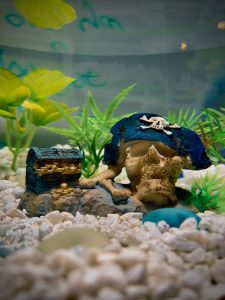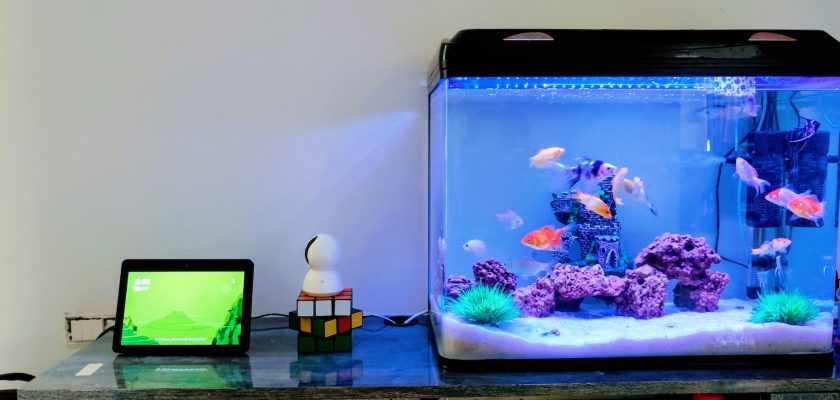Keeping a filter clean in your fish tank is essential. Your fish will be much happier and healthier if you take the time to clean your filter. If you want to make sure that your tank is properly cleaned, you can follow a few simple steps.
Vacuum the gravel
Gravel plays an important role in the fish tank ecosystem. It provides a habitat for the many helpful bacteria and parasites that live in it. They also help maintain the water quality, which is important for keeping the fish healthy.
Gravel can become dirty and accumulate a variety of unwanted debris. This can cause problems, including foul smelling water and ammonia poisoning. If you need to clean your gravel, a vacuum can be a great tool.
A good gravel vacuum will help you efficiently remove dirt and waste from your aquarium. It is important to purchase the correct size for your tank. Choosing the right sized vac will save you time and energy.

Photo by Jadon Barnes on Unsplash
For a small aquarium, you can use a one-inch wide opening. However, if you have a bigger tank, you might need to purchase a longer tube. You can also choose a siphon-style vacuum, which is the most popular option for cleaning your aquarium.
When choosing a vacuum, check to see if it has a faucet attachment, as this will allow you to easily refill the tank after you have vacuumed it. Make sure to read the manufacturer’s instructions before using the vacuum.
You can also use a turkey baster to remove waste from your tank. While this method is not as efficient as a gravel vacuum, it will still work.
Be careful not to over-vacuum your tank, as this can cause a decrease in biological filtration. Also, don’t replace all of the water. Water changes should be done in stages.
Use the vacuum cleaner’s head to sift and suck out the gravel and other debris from your tank. The best way to do this is to move the vacuum slowly and carefully, as this will ensure that you will not swirl the gravel around too much.
Vacuuming your fish tank can be a fun and easy way to keep it looking and feeling fresh. Before you begin, be sure to check the health of the water and the health of your fish. Keep your hands dry and protected with aquarium gloves.
Replace the filter sponge
Changing the filter sponge in a fish tank is easy and not as difficult as you might think. You will have to do it periodically though.
When you need to change the filter sponge in a fish tank, you should make sure to follow these steps. This should help you avoid damaging the bacteria that will be present in the filter. It is also important to monitor pH and hardness.
In general, you should change your filter media every six weeks. However, this can vary depending on your specific fish and tank.
To change the filter sponge in a fish tank, start by removing the media from the aquarium. Then, siphon water from the tank into a bucket. Alternatively, you can use an air pump. Just make sure to use a safe source of water, such as distilled or reverse osmosis water.
Once you have removed the old sponge, rinse it well. Do not rewash it in tap water. Tap water contains chlorine, which can kill helpful bacteria.
For biological sponge filters, you should clean the filter media in the aquarium water you previously had in your tank. A canister filter can suddenly conk out. Also, do not try to fix the sponge by soaking it in new water.
If your aquarium water is contaminated with phosphates or nitrates, you will need to treat it organically. Some hobbyists run a temporary hang-on-the-back filter to remove these unwanted materials.
If you have a larger tank with several sponge filters, you can set them up on either end of the tank. These will reduce dead spots and improve the flow of water.
Sponge filters provide similar biological benefits to other types of filtering. They also are easy to maintain. But, they may not provide as strong of filtration as other types of filters.
Sponge filters are a good option for fry or shrimp tanks. They are also used to create hospital tanks. Although they are not as efficient as other types of filters, they are a popular choice for quarantine or breeder tanks.
Whether you’re setting up a small tank or a large, multi-tank system, you’ll need to plan ahead to ensure that you’re getting the most out of your system. With the right planning, you can get a high quality, effective filter without breaking the bank.
Balance cleanliness with biological activity
When it comes to cleaning your fish tank, your water filtration system has to be top of its game to keep your aquatic inhabitants happy and healthy. This may sound like a chore, but with a little forethought you can have the cleanest tank on the block in no time at all. And you won’t have to worry about your aquatic companions snatching your swag as you slum it out in the backyard. As long as you remember to keep your eyes and fingers crossed, the entire process will be a breeze.
Using the right cleaning solutions will pay off in spades in the form of healthier fish and cleaner water. And the benefits of having a slick system don’t stop at the filter itself. In fact, some systems allow you to clean the entire tank in one go, a feat of econometrics that can’t be said for the aforementioned poxy. If you’re lucky, you may even get to hang out with the critters while you’re at it. So if you’re the sort who enjoys a rousing game of ping pong, you’ll be glad you have a good system. You might even make a few friends along the way.
To top off the shindig, you’ll need a few tricks of the trade to make sure you don’t end up with a pile of mud on your hands. To that end, you’ll want to arm yourself with the right tools, like a good pair of gloves and a bucket of cold water.
Precautions to maintain a filter
The filter of your fish tank is the heart of your aquarium and needs to be cleaned regularly. Its condition can affect the health of your fish. Before cleaning your filter, it is advisable to test your water. If the level is low, this could be an indication of a problem.

Photo by Hobi industri on Unsplash
A dirty filter can harbor bacteria and viruses that can kill your fish. Unwanted material is soluble in water, so it will pass through any filter medium. Chemical filtration can remove certain substances.
For an external filter, the media will need to be rinsed every six months or so. However, in-tank power filters will need to be cleaned about every two weeks. Large filters will not need as frequent cleaning as smaller ones.
If you have a multi-filter system, it is best to rinse only one filter at a time. In addition, you should check the flow of your filter on a regular basis. If it is not flowing well, it may be time to replace your media.
You should also monitor the temperature of your aquarium. Hot water can damage the filter media. Also, if you use a pump, make sure that it is clean. If there are any obstructions in the inlet cage, such as algae or debris, it should be cleared.
If you are using a canister filter, the media should be kept wet during the cleaning process. This will help prevent the media from drying out.
If you have an air driven sponge filter, you will need to clean the impeller of the pump. Additionally, you will need to service the air lines.
It is important to follow the instructions on your filter’s instruction sheet. Make sure that you have written down the date of the last cleaning of the filter.
When you are rinsing your filter, you must make sure that you use only clean water. Never use chlorine or chloramine in your water. Instead, use warm, de-chlorinated water. Chloramines are harmful to the fish.
Fish should be fed only in moderation. Overfeeding can cause excess waste in your tank.
